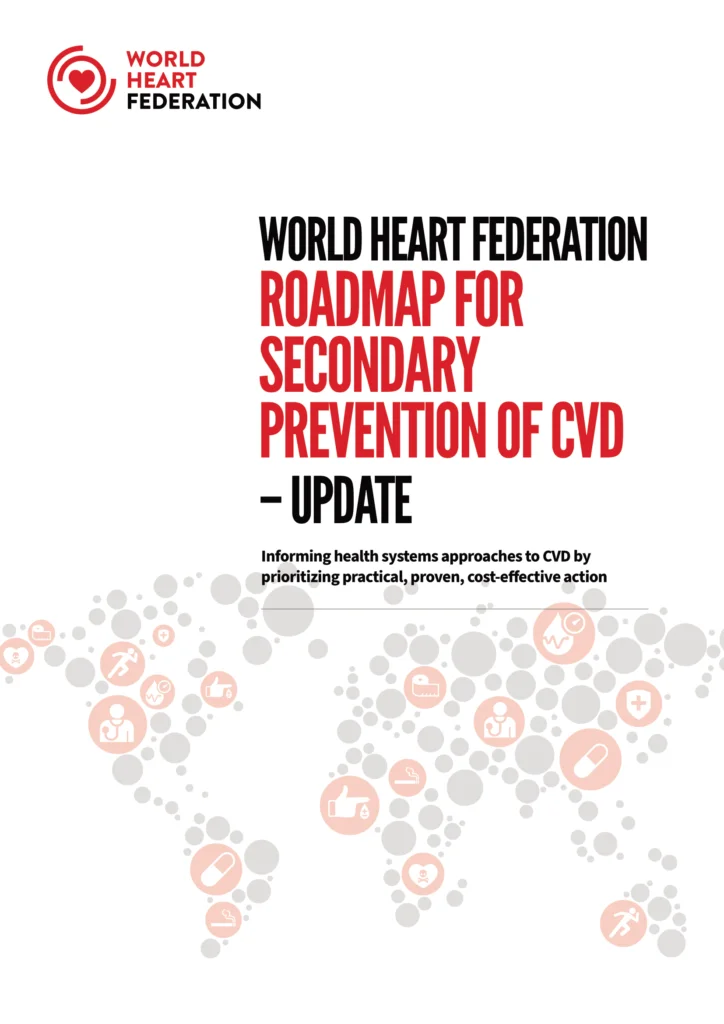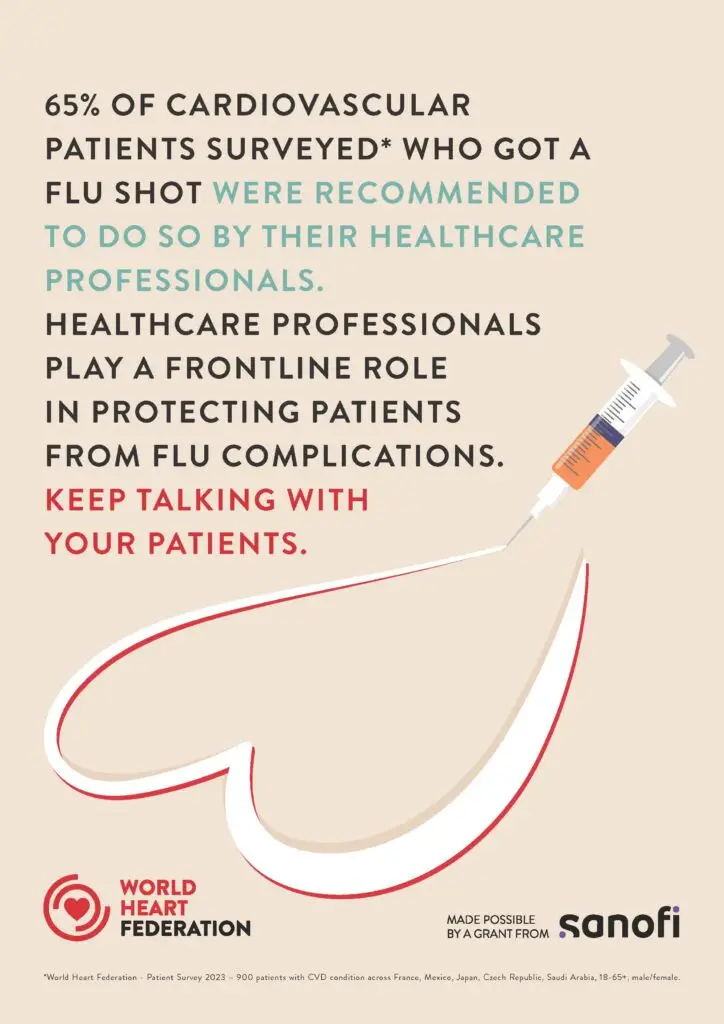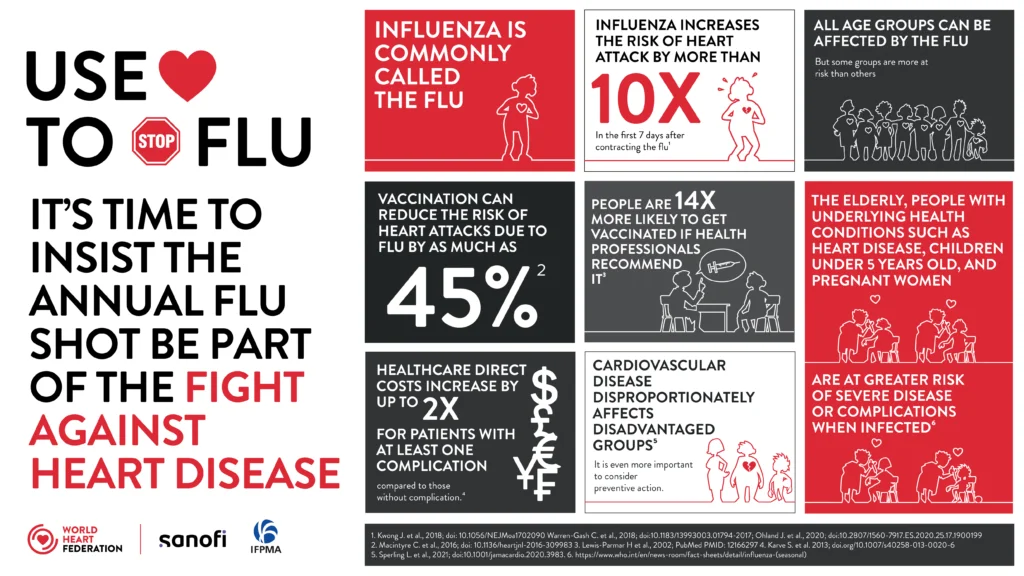Having a healthy, active lifestyle can help prevent CVD
Despite being largely preventable, cardiovascular disease (CVD) causes more than 20.5 million deaths every year.
An estimated 80% of cardiovascular disease, including heart disease and stroke, is preventable.
The main elements of CVD prevention are healthy diet, physical activity, avoiding tobacco, and “knowing your numbers”.
35M
people have an acute coronary or cerebrovascular event every year
High blood pressure is the leading risk factor for CVD globally
There are many risk factors associated with heart disease and stroke. Some risk factors, like family history, cannot be modified, while others, like high blood pressure, can be modified through lifestyle interventions and treatment. Millions of people worldwide struggle to control the risk factors that lead to cardiovascular disease, and many others remain unaware that they are at high risk.
The most important behavioural risk factors of heart disease and stroke are unhealthy diet, physical inactivity, tobacco use and harmful use of alcohol. These behaviours can lead to raised blood pressure, diabetes, high cholesterol, overweight and obesity, which can in turn be measured in order to assess an individual’s risk of developing cardiovascular disease.
While individual choices play a part in these behaviours, government and policymakers also play an important role in ensuring people have access to the tools they need to live a healthy life, including clean air, affordable healthy food, and well-planned urban spaces that encourage an active lifestyle. Health policies that create environments where healthy choices are not only available, but also affordable, are essential for motivating people to adopt and sustain healthier lifestyles.
Addressing just one risk factor, such as exercising more, will help, but in order to significantly reduce your risk of CVD, it’s important to look at your lifestyle as a whole. If you are already living with CVD, staying healthy and active can help you live longer and reduce the chances of it getting worse.
What can you do to lower your risk of cardiovascular disease?
According to the World Health Organization, as many as 80% of all heart attacks and strokes are preventable. The majority of deaths due to CVD are precipitated by risk factors such as high blood pressure, high cholesterol, obesity, or diabetes, which can, to a large extent, be prevented or controlled through the consumption of a healthy diet, regular exercise and avoiding tobacco. Keeping an eye on your blood pressure, cholesterol levels and blood sugar levels is also very important.
Eat a healthy and balanced diet
Eating a healthy, balanced diet is crucial to maintaining a healthy heart and circulation system. A healthy diet should include a wide variety of unprocessed and fresh foods, including plenty of fruit and vegetables (at least five portions every day), whole grains, nuts and foods low in saturated fats, sugars and salt. Be wary of processed foods, which often contain high levels of salt, and drink lots of water!
Exercise regularly
It only takes 30 minutes of moderate-intensity physical activity, five days a week, to improve and maintain your health. Adults (aged 18-65) and seniors (65+) should aim to do at least 150 minutes of moderate-intensity physical activity, or at least 75 minutes of high-intensity physical activity, every week. Children and adolescents should do at least 60 minutes of moderate- to vigorous-intensity physical activity every day.
Try to make exercise a regular part of your life: use the stairs instead of the lift, get off the bus a few stops earlier and walk the rest of the way. Being active is also a great way to relieve stress and control your weight, which are both risk factors for cardiovascular disease.
Maintain a healthy body weight
Lowering your risk of overweight and obesity normally involves reducing the number of calories consumed from fats and sugars, increasing the portion of daily intake of fruit, vegetables, whole grains and nuts, and exercising regularly. At least 60 minutes of exercise most days a week will help you maintain a healthy body weight.
Avoid tobacco use
If you stop smoking, your risk of coronary heart disease will be halved within a year and will return to a normal level over time. Avoid smoke-filled environments: exposure to second-hand smoke significantly increases the risk of heart attack. All forms of tobacco are harmful, and there is no safe level of exposure to tobacco. If you’re having trouble quitting tobacco, talk to your doctor about developing a tailored plan to suit your needs.
Avoid alcohol
As with tobacco, there is no safe level for drinking alcohol, and the detrimental effects of alcohol far outweigh any potential protective benefits. While drinking less may reduce your risk of CVD, evidence shows that the ideal situation for health is to not drink at all. Even moderate drinkers notice health benefits when they stop drinking alcohol.
Know your numbers
Knowing your numbers is an important part of keeping your heart healthy. Checking your blood pressure, cholesterol levels and blood sugar levels on a regular basis is important to help determine and control your risk of developing cardiovascular disease.
- Know your blood pressure: High blood pressure, or hypertension, is one of the biggest causes of heart attack and stroke. It usually has no symptoms, so it’s important to get it regularly checked and, if needed, take the necessary measures to lower it, which may include dietary changes, increased physical activity, and medication.
- Know your cholesterol: High levels of cholesterol in your blood also increase your risk of cardiovascular disease, including heart attacks and strokes. Blood cholesterol can normally be controlled through a healthy diet and, if necessary, by appropriate medications.
- Know your blood sugar: High blood sugar, or hyperglycemia, is a common problem for people with diabetes. Higher blood sugar levels increase your risk of heart attacks and strokes, so it’s important to know your numbers and take any necessary precautions to control your blood sugar.
Take your medication as prescribed
If you have a higher risk of developing heart disease or stroke, you may need to take medication to reduce your risk. These can include statins to lower blood cholesterol levels, low-dose aspirin to prevent blood clots, insulin for diabetes and tablets to reduce blood pressure. Take the medication that your doctor has prescribed and make sure you stick to your regiment.
Know the warning signs
The sooner assistance is sought, the greater the chances of a full recovery. Learn about CPR and get certified from your local organization so that you are able to help out in case someone goes into sudden cardiac arrest.
Primary, secondary and tertiary prevention of CVD
For many people, the first sign and only symptom of cardiovascular disease is a heart attack or stroke. Strategies to prevent cardiovascular disease in people at higher risk are therefore crucial to reduce the global burden of CVD. The most effective prevention interventions identify and target people at higher risk before they develop a condition.
Primary prevention mainly targets people who are at high risk of CVD but who have not yet developed a cardiovascular condition. Interventions aim to prevent the onset of disease, which is achieved primarily by maintaining a healthy lifestyle through a healthy diet and regular exercise.
Secondary prevention targets people with established cardiovascular disease. It refers to preventing heart attack and stroke through drug therapy and counselling for high risk individuals – such as those with previous events or known cardiovascular diseases. Secondary cardiovascular prevention can be defined as any strategy aimed to reduce the probability of a recurrent cardiovascular event in patients with known cardiovascular disease. Interventions focus on early diagnosis to reduce the impact of CVD prior to any critical or permanent damage. Early diagnosis allows health professionals to provide the necessary care for patients to reduce their risk of CVD, and treatment can include medications and lifestyle changes. With the exception of certain medications, most secondary prevention interventions also apply to primary prevention.
Tertiary prevention targets people who are already affected by cardiovascular disease and who are already experiencing its long-term effects, and aim to increase life expectancy and improve quality of life. It usually involves major procedures to prevent recurrent symptoms, further deterioration of the disease, and subsequent cardiovascular events. These include coronary angioplasty, stent, bypass surgery, pacemakers, defibrillators, and left ventricular assist devices. For this reason, tertiary prevention is generally more costly and invasive than primary and secondary prevention.
Primordial prevention
The aim of primordial prevention is to prevent CVD at a very early stage. While primary prevention is about treating and modifying existing risk factors to prevent the development of CVD, primordial prevention focuses on preventing the development of the risk factors themselves.
Most instances of CVD can be prevented by addressing risk factors before they create health problems, such as tobacco use, unhealthy diet and obesity, physical inactivity, harmful use of alcohol and air pollution. Interventions at this level normally involve legislative policies such as smoking bans, taxation on sugary drinks and strategies to reduce sodium in foods.
Latest News
Implementing the WHF Roadmap for Secondary Prevention of Cardiovascular Disease
“Through my secondary prevention programme, I have discovered the power of self-care and prioritising my health.” Such valuable patient testimony reflects the crucial need for access to follow-up treatment after a cardiac event such as a heart attack or stroke. The “know-how” exists. Every year, 20.5 million people die from cardiovascular disease (CVD), close to […]
Prevention
Taking up arms against the flu
Guest post: Professor Laurence Sperling, Katz Professor in Preventive Cardiology and Professor of Global Health, Founder of The Heart Disease Prevention Center at Emory University and Past-President of The American Society for Preventive Cardiology. The heart is not the first organ we think of during influenza (flu) season. Yet, although influenza impacts the respiratory system, […]
Prevention
SASNET GHANA urges action to prioritize CVD prevention and control
Last year, the Stroke Association Support Network-Ghana (SASNET GHANA) launched a national campaign aiming at identifying policy gaps and priority areas of intervention to reduce the burden of cardiovascular disease (CVD). The campaign, which took place in the lead-up to World Heart Day 2020, received the support of the World Heart Federation through the World […]
Prevention
Universal Health Coverage
Rwanda Heart Foundation raises awareness on cardiovascular risk factors and the importance of heart disease prevention
The Rwanda Heart Foundation (RHF) launched an educational campaign to raise awareness on cardiovascular risk factors and the importance of heart disease prevention. The campaign, which took place in two phases, in the lead up of the World Heart Day 2019 celebration and over the next months, received the support of the World Heart Federation […]
Prevention





